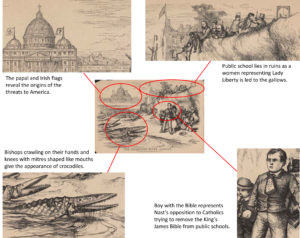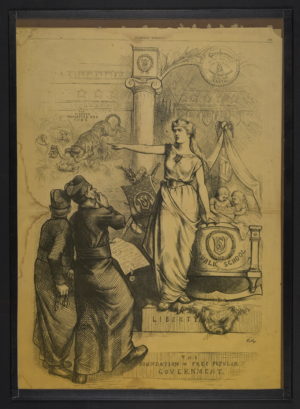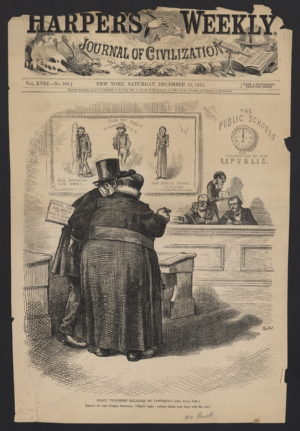Education
Nast believed that Catholics were attacking the public school system, which he saw as essential to American freedom and democracy. At this time, Catholics were protesting the use of Protestant bibles in public schools. Also, the rise of parochial schools (schools run by a parish) and attempts by politicians to use government money to fund these schools caused concern that public schools would be completely replaced.
“The American River Ganges. The priests and the children,” December, 30, 1871
One of Nast’s most famous cartoons, “The American River Ganges,” depicts bishops shaped as crocodiles coming to devour children as a public school lays in ruins. Nast believed that Catholicism was attacking the future of the country by destroying public schools.
“Tilden’s “Wolf at the Door, Gaunt and Hungry.” Don’t let him in,” September 16, 1876
Here a wolf with a papal and Democratic Party collar is trying to force its way into a school room as the children barricade the door. In the background of the cartoon, Uncle Sam can be seen grabbing a gun implying that the only way to protect the schools, and by extension America, is to eliminate the Church.
“Madness (Yet there’s method in it),” January 15, 1876
This cartoon takes much of its inspiration from William Shakespeare’s Hamlet as Uncle Sam banishes a nun from a school to a convent. Nast’s anti-Catholic sentiment was made even clearer by the use of the Shakespeare quote that the nun, representing the Church, makes monsters out of men.
“Beware,” July 3, 1875
Lady Liberty protects the public schools from two Roman Catholic priests who want to chain the children to the Church. However, the priests are turned away by the image of a tigress protecting her clubs. In this cartoon, Nast is urging Americans to take the same approach to protect their children’s education.
“Shall Teachers’ Salaries Be Lowered?”December 19, 1874
This print shows a Catholic priest and another man (most likely a politician or lawyer) standing in front of the board of education while holding a paper that reads “Reduce the salaries of the public school teachers.” Printed below the title is the line: “Enemy of the Public Schools. ‘That’s right: reduce them, and they will die out.'” Nast is commenting on an historic reduction in the salaries of New York public school teachers and blaming it on a Catholic conspiracy to take over the schools.
“Romish Ingratitude,” July 13, 1872
Uncle Sam, holding an axe labeled “Order”, attacks a large snake with the head an Irish American, while Lady Liberty shields children of various races. Nast is suggesting that while other European, Asian, and African races respect the idea of equal rights for all, the Irish driven by their Catholicism want to poison American liberty. Nast and other contemporary cartoonists often depicted the Irish with ape-like features to showcase the groups’ inferior and animalistic nature.
Nast’s cartoons reveal deep-seated animosity towards the Catholic Church. Nast feared a takeover of the United States by the pope and saw threats everywhere, most notably to public education. His cartoons have had a large impact on how Catholics are depicted even today.








